The Ro-ToBI Annotation System
At the intonation description level, the Ro-ToBI annotation system labels only the single pitch events. Their grouping into prosodic units results from the information of the break indices tier that refers to the beginning or to the ending groups.
We have extended the framework of the ToBI annotation system by introducing a more general concept of pitch accent instead of the pitch accent as a local pitch movement during the accented syllable, to annotate all events that generate a focus in the Romanian intonation (pitch accents and/or emphases). We have distinguished between local (narrow) pitch events (generated by pitch accents at the syllable level) and broad pitch events (generated by certain pitch patterns at the prosodic word level and even at the prosodic group level).
To annotate the narrow focuses we started from the ToBI label set and extended it by several new labels to make our annotation more accurate in certain pitch contexts. We also used some labels from the Cat_ToBI annotation system [2, 8], which can also describe certain tonal contexts in Romanian.
The broad pitch events have been annotated by narrow pitch event labels prefixed by a special sign that indicates that they have referred to the whole word pattern. Similarly to the narrow pitch event annotation, these labels were assigned to the accented syllable of the annotated word, too.
The labels assigned to the pitch events used in intonation annotation consist in tonal marks: H for high levels and L for low levels. The tones can be affected by the following prominence attributes coded as follows:
- '*' - denotes a target tone of a pitch accent;
- '~' - is an attribute that signifies that the beginning and the ending tones of a prosodic word have approximately the same level;
- '!' - indicates a downstepped high level compared with a higher previous tone;
- '^' - indicates an upstepped level compared with a higher previous tone.
The Ro-ToBI inventory of pitch accents
The basic pitch accent inventory consists in the following labels:
- H* - is a pitch accent with a high target tone pitch movement. It is often phonetically realized by a large or small rising tonal movement or by a jump up to a relatively high target tone during the accented syllable. The H* pitch accent can also have a tendency of keeping the pitch movement close to a high tonal level during a prosodic word. Usually, it is involved in generating a PUSH event at a phrase level. It can generate an emphasis when its target tone reaches the highest tonal level during an accented syllable, within the descending melodic contours.
- L* - is a pitch accent with a low target tone pitch movement. It is often phonetically realized by a large or small decreasing tonal movement or by a jump down to a relatively low target tone during the accented syllable. The L* pitch accent can also have a tendency of keeping the pitch movement close to a low tonal level during a prosodic word. Usually, it is involved in generating a POP event in statements, imperative sentences or wh-questions. It can generate focuses within the ascending melodic contours (yes-no questions, echo wh-questions) when its target tone reaches the lowest tonal level within a prosodic unit.
- L+H* - is assigned to a contour that begins by a slowly rising movement from a relatively low tone and reaches a high target tone during the following steeper rising movement, at the end of the accented syllable. It generates local or global focuses. If the melodic contours are descending, the global focus is generated during the L+H* pitch accent. If the melodic contours are ascending, the global focus is generated during the L+H* pitch accent when the L tone reaches the lowest level of the tonal space.
- L+>H* - is assigned to a contour that displays a small rising movement from a relatively low tone during the accented syllable and reaches a higher target tone by continuing the rising movement during the next unaccented syllable. The L+>H* pitch accents often rise the pitch contours to high levels within the descending melodic contours (giving rise to a PUSH event prominence), without generating focuses.
- H*+>L - is assigned to a contour displaying a H-type pitch accent followed by a very steep decreasing pitch movement during the next unaccented syllable of the same word or of the next word. It generates a prominent tonal contrast between the high target tone during the accented syllable and the low tone reached on the next syllable. Therefore, it emphasizes the word related to the accented syllable. For example, it can be found in wh-questions, emphasizing the wh-word.
- H+!H* - is a pitch accent phonetically realized as a steep fall from a high tone to a lower level high tone on the accented syllable. A jump to a high tone can occur before the vowel of the accented syllable. In nonneutral statements, this type of accent generates focuses on the words lying on the descending part of a melodic contour. During this pitch accent, a high target tone (close to the top of the tonal space) is reached at the beginning of the accented syllable. Then, the F0 contour follows a descending trend.
- H+L* - is a pitch accent phonetically realized as a fall from a relatively high level (reached during the pretonic syllable) to a low target tone, during the accented syllable. In neutral statements, it can generate more prominent POP/POP+FOCUS events.
- L*+H - is a pitch accent phonetically realized as a constant pitch movement at a relatively low level or as a small decreasing pitch movement to a low target tone, during the whole accented syllable or only during its first part. In all cases, the pitch movement is followed by a prominent rising movement during the post-accented syllable or only during its last part.
The "~" sign, placed before a H* or L* label, adds information to the F0 contour at the prosodic word level (the beginning and the ending tones of a prosodic word have approximately the same level).
The ~H* label can be used within various F0 contour contexts:
(a) when it is placed between two high pitch events, it indicates either a flat F0 contour of the corresponding prosodic word or a pitch movement having some variation;
(b) when it is placed between two low tonal events, its F0 contour displays a rising, followed by a falling pitch movement, generating strong focuses on the monosyllabic words.
Similarly, a low level plateau pitch accent can be annotated by a ~L* label when the prosodic word has the same level at its beginning and its end. For the ascending contours, the ~L* labels can be assigned to the word in the focus position when the tone reaches the lowest level of the tonal space.
The Ro-ToBI inventory of boundary tones
The set of boundary tones consists in monotonal events: low-L%, high-H%, M%-medium and bitonal events: LH%, HL%, HH%:
- L% - The Low boundary tone can be found at the end of the descending melodic contours of statements, wh-questions, imperative wh-questions and imperative sentences (requests, commands).
- H% - The High boundary tone can be found in confirmation-seeking yes-no questions, imperative echo wh-questions, conter-expectational echo yes-no questions and imperative yes-no questions.
- M% - Within the analyzed corpus, the Medium boundary tone was found in a vocative sentence.
- LH% - The Low-High boundary tone sequence was found in information-seeking yes-no questions with the emphasis in the final position, imperative yes-no questions and in neutral echo yes-no questions.
- HL% - The High-Low boundary tone sequence was found in information-seeking yes-no questions with the emphasis in a nonfinal position and in a vocative sentence.
According to the ToBI conventions (J. Hirschberg and M.E. Beckman 1994), we have used the following break indices:
- 0 - to mark the clitic words within a prosodic word;
- 1 - to mark the end of a prosodic word (AU);
- 2 - to mark the end of an AUG at the phonological group level;
- 3 - to mark the end of an AUG at the intermediate phrase level (corresponding to a H- or L- accent phrase);
- 4 - to mark the end of an AUG at the intonational phrase level (corresponding to a H% or L% boundary tone).
Examples
Examples of pitch accents
The H* pitch accent
The H* pitch accent generates the PUSH event of the second IP that is partitioned by a PUSH - POP + F event sequence. The PUSH and POP+F events correspond to the verb and to the focused word Lima, respectively.
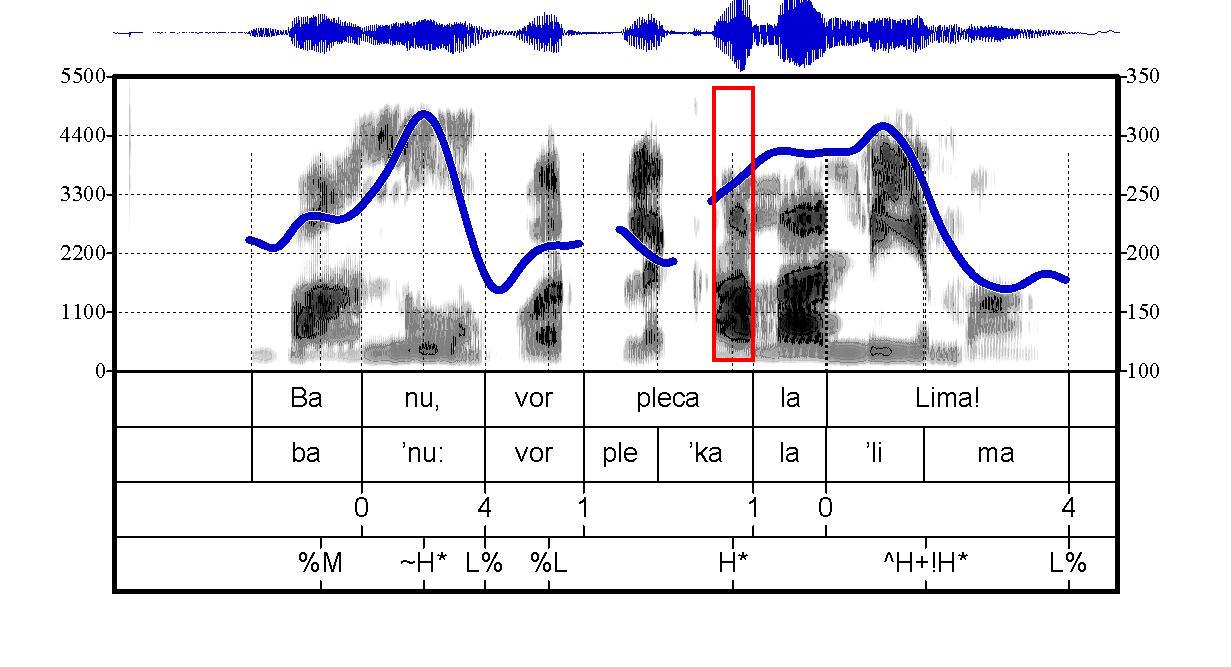
The L* and ~L*pitch accents
The figure presents two types of low pitch accents: one annotated by L* as in the ToBI annotation system and another annotated by ~L* label (indicating a small variation around a low tonal level), in the Ro_ToBI system. They generate two focuses of different prominences on the object and on the verb. This is a nonneutral yes-no question utterance characterized by a PUSH+focus – POP+FOCUS partition.
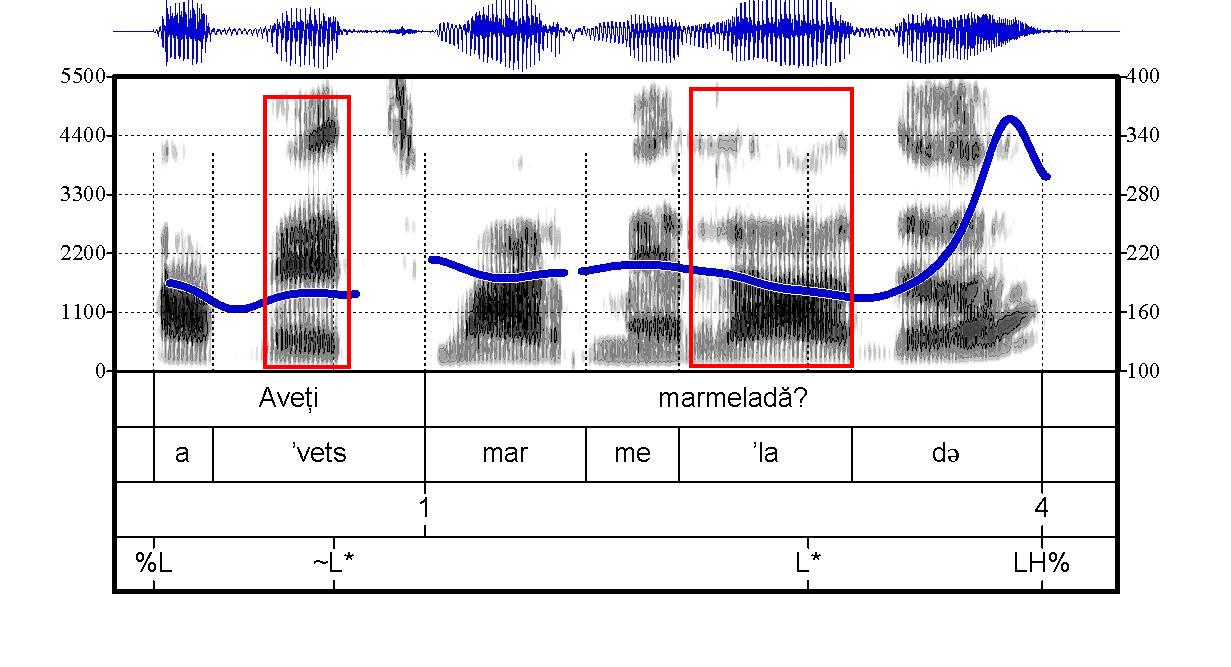
The L+H* pitch accent
The F0 contour in Fig. 3 corresponds to an enumeration, with each term focused by L+H* pitch accents, within similar intermediate phrases.
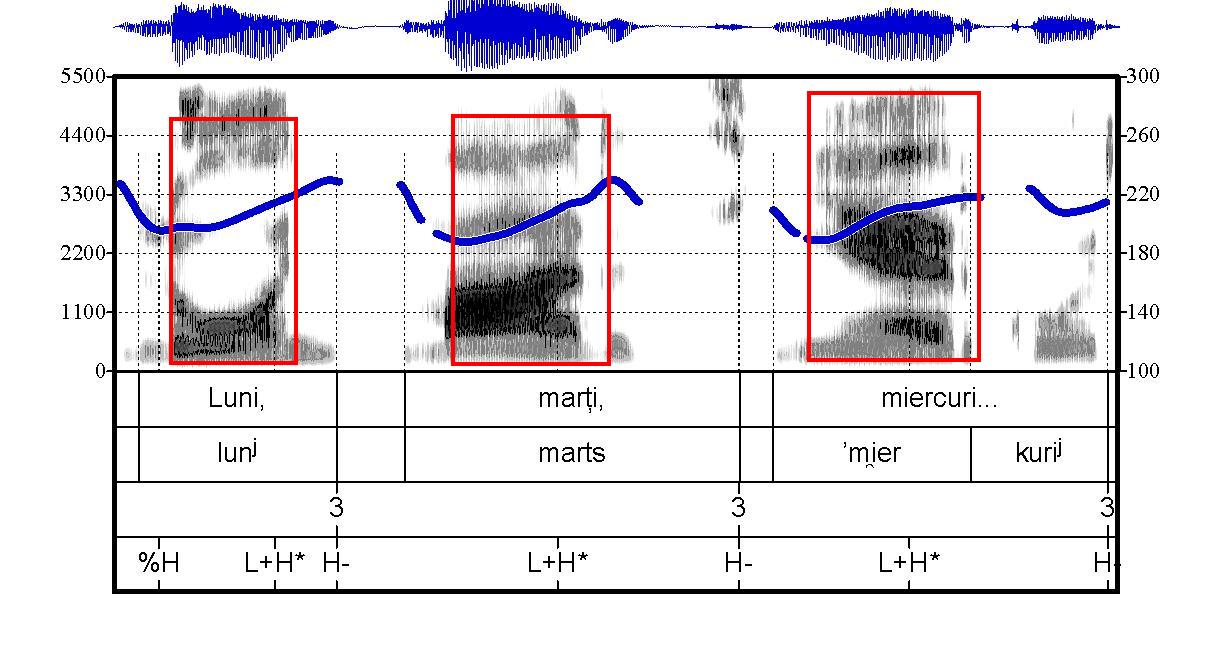
The L+>H* pitch accent
The L+>H* pitch accent generates the PUSH event within this intonational phrase with a PUSH - Focus - POP partition. The three events correspond to the Subject+ Verb+ Object syntactic structure of the statement.
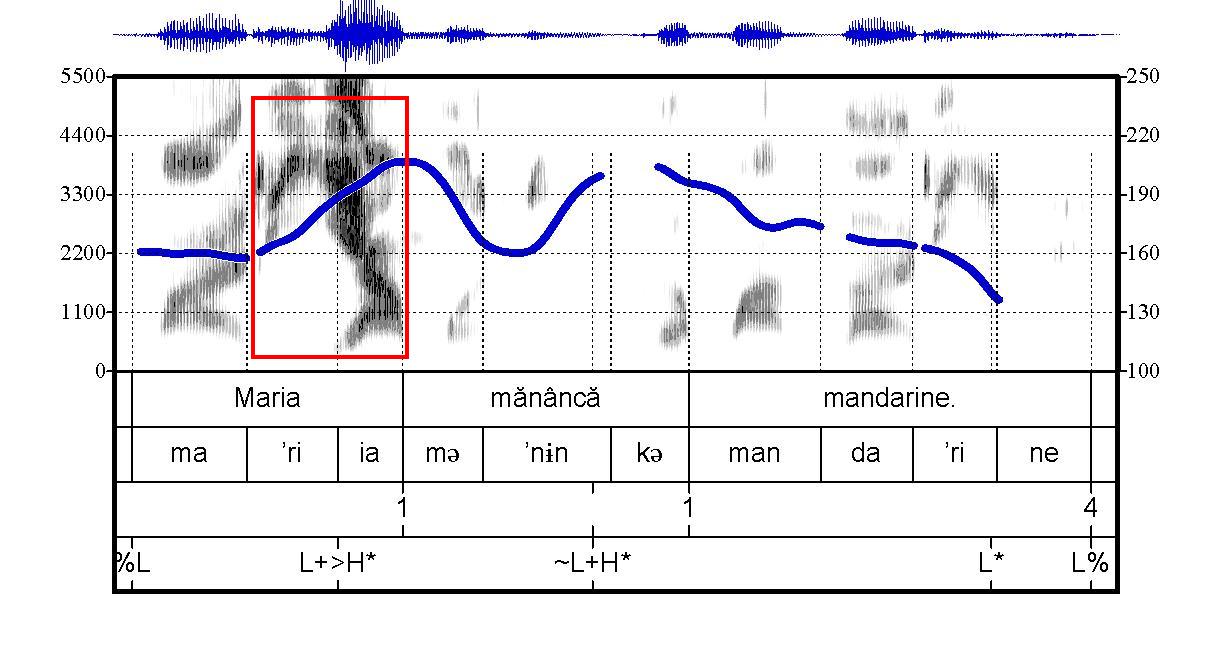
The H*+>L pitch accent
The H*+>L pitch accent generates the emphasis (focus) on the negation word "nu" within the negative statement "S-ar putea.....". The fall to a relatively low tone after the high tone during the word "nu" increases the prominence of the emphasis (focus).
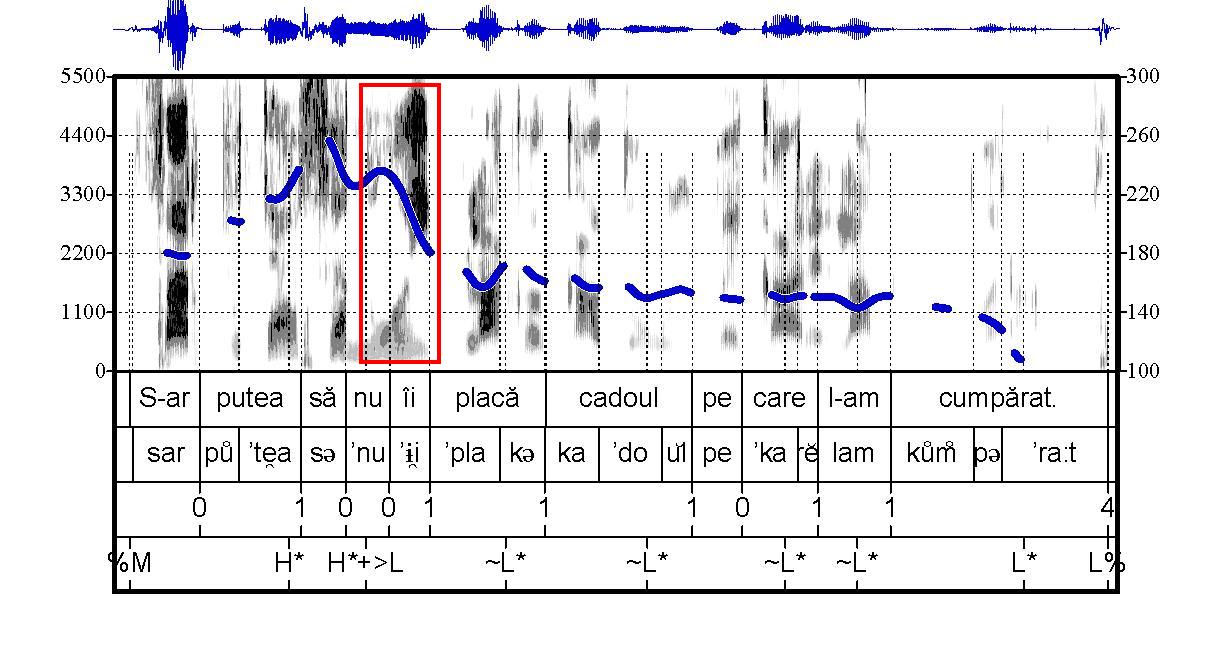
The H+!H* pitch accent
The H+!H* pitch accent generates a prominent focus on the word in the final position of a nonneutral statement. The high target tone of the pitch accent at the top of the tonal space increases this prominence by generating an emphasis.
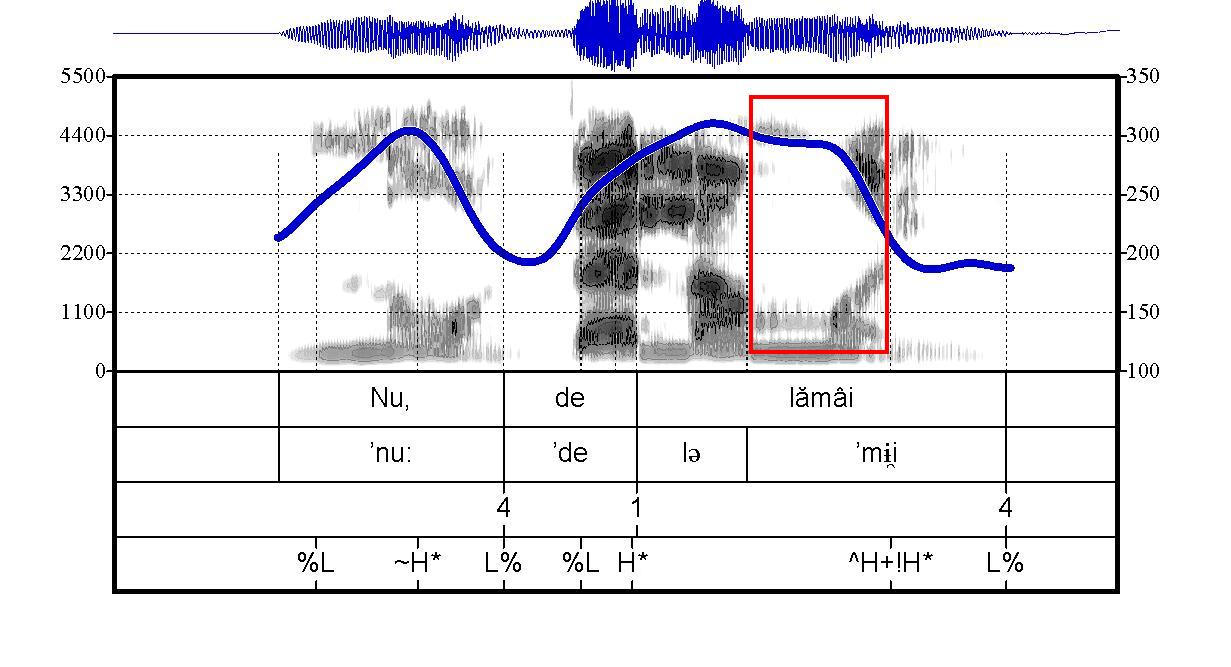
The H+L* pitch accent
The H+L*pitch accent increases the prominence of a POP event in the final part of an IP corresponding to a neutral statement.
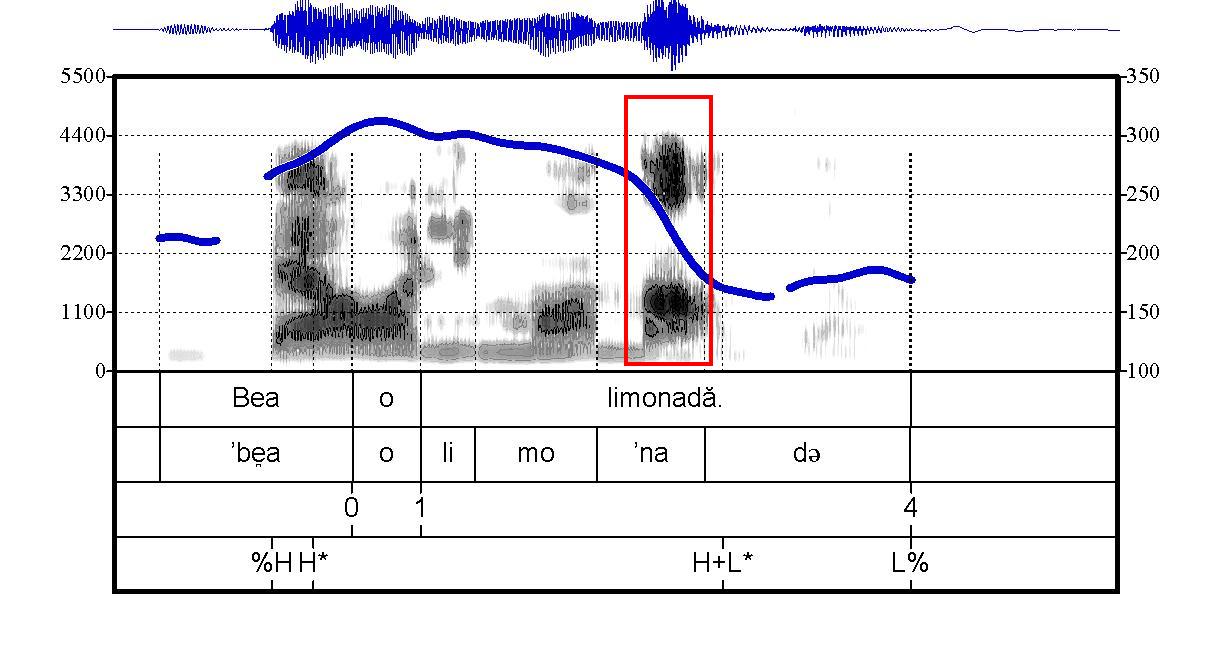
The L*+H pitch accent
The L*+H pitch accent generates emphases and focuses in the final part of the interrogative sentences with ascending melodic contours. They are more prominent for the low-high variation on the same syllable and less prominent when the F0 contour maintains a low level during the accented syllable, then rises on the next nonaccented syllable.
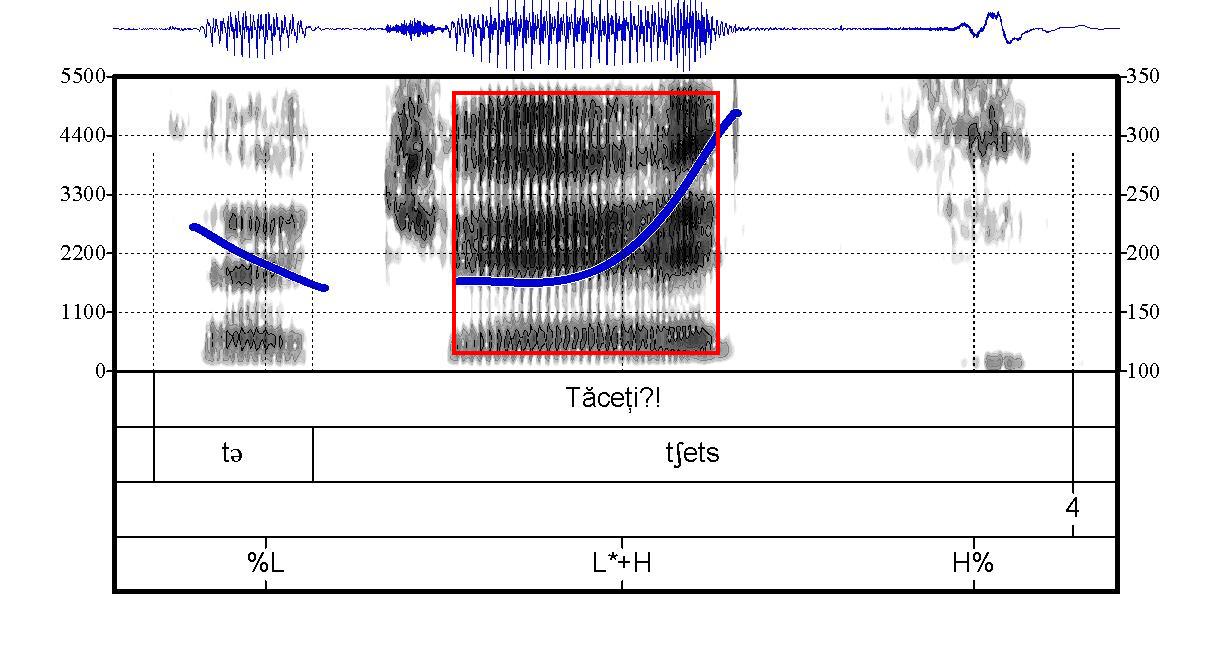
The ~H* pitch accent
Statements: Contrastive focus
The ~H* pitch accent is generated on the accented syllable within a F0 contour that has two targets: the first one is reached during the accented syllable and generates a high pitch accent; the second one is reached when the last prosodic word begins with and ends in the same tonal level. If both the rising and the falling pitch movements occur during the accented syllable (as in the case when the corresponding peak is aligned with the mid of the accented syllable), a very prominent pitch accent is generated in nonneutral statements. For the less nonneutral melodic contours, the peak is aligned to the right of the accented syllable. Consequently, the descending pitch movement to the final target occurs on the next unaccented syllable.
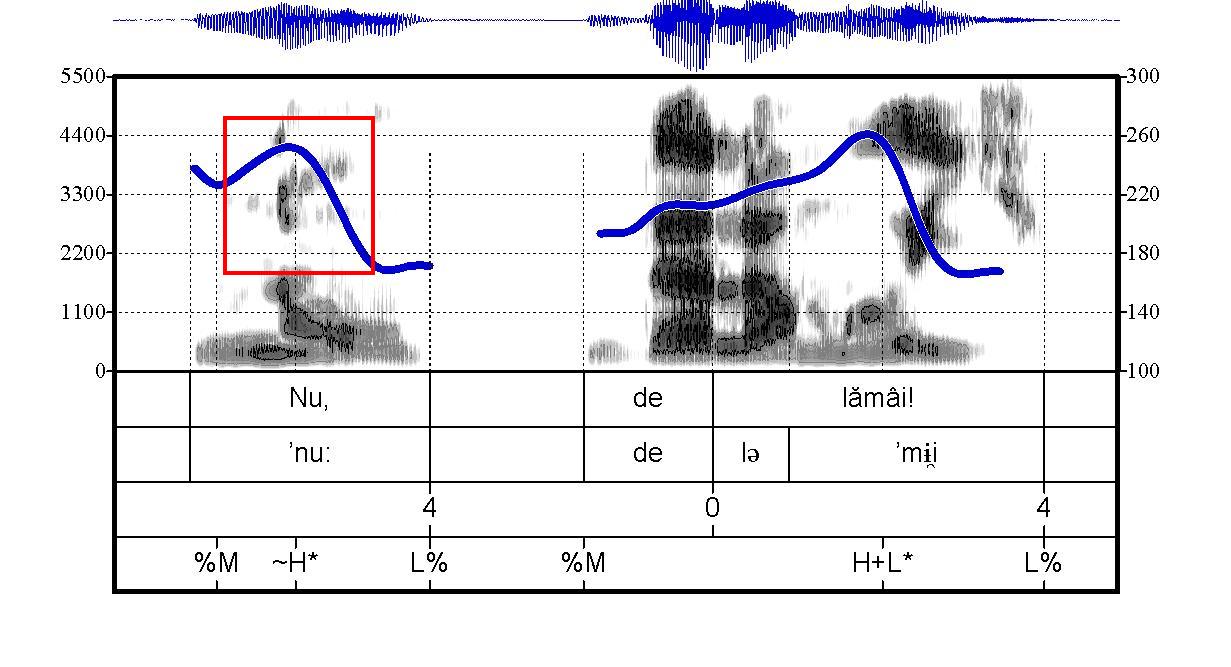
Examples of boundary tones
The L% boundary tone
The statements, the imperative sentences and the wh-questions have descending melodic contours that end in low boundary tones.
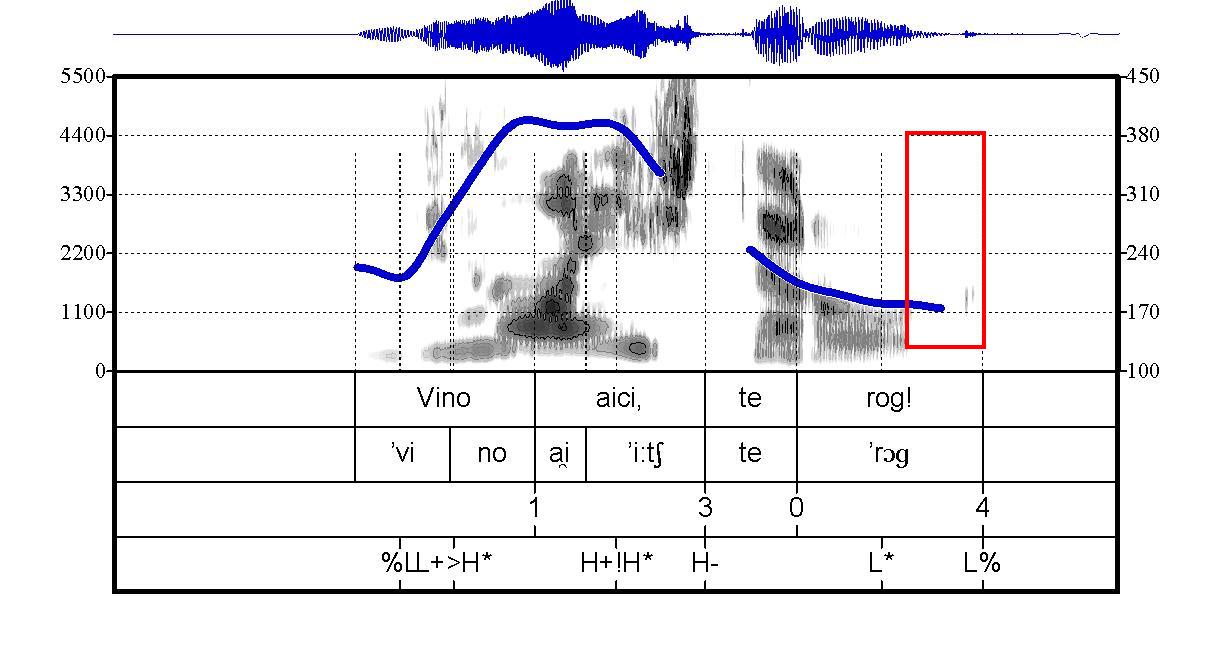
The H% boundary tone
The yes-no questions with the emphasis in the final position and various types of echo questions have ascending melodic contours that end in high boundary tones.
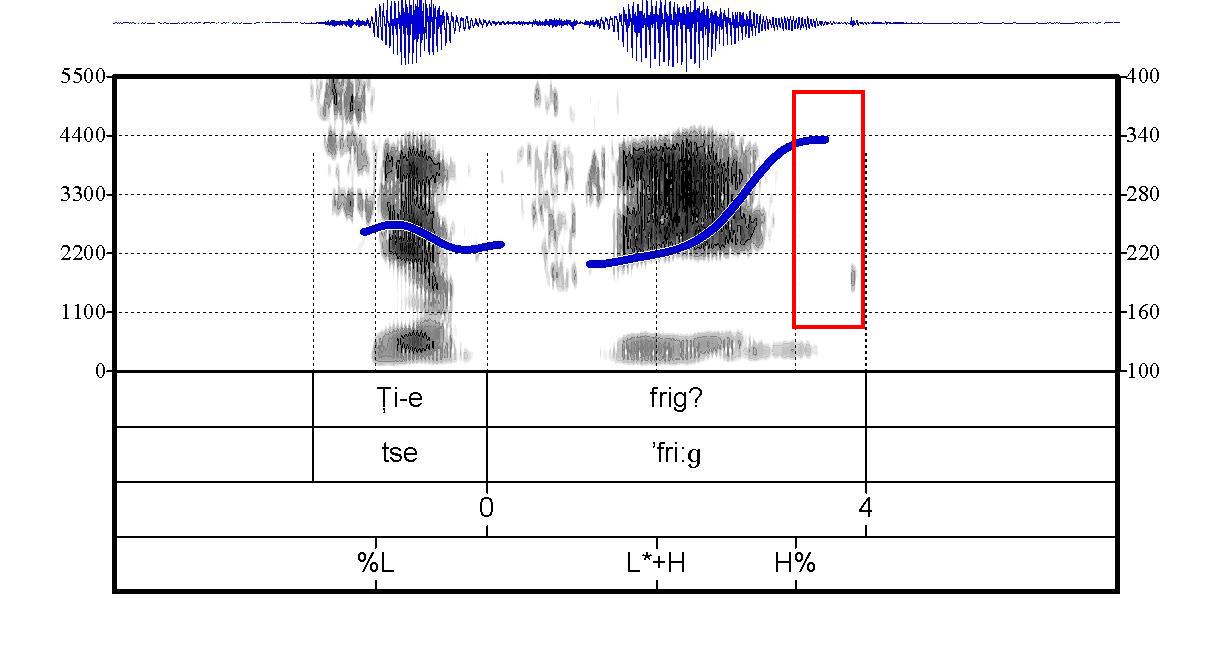
The M% boundary tone
The melodic contours of the vocative sentences - first call end in relatively high boundary tones. In most cases, their levels are lower that the previous high tones (H% or !H%).
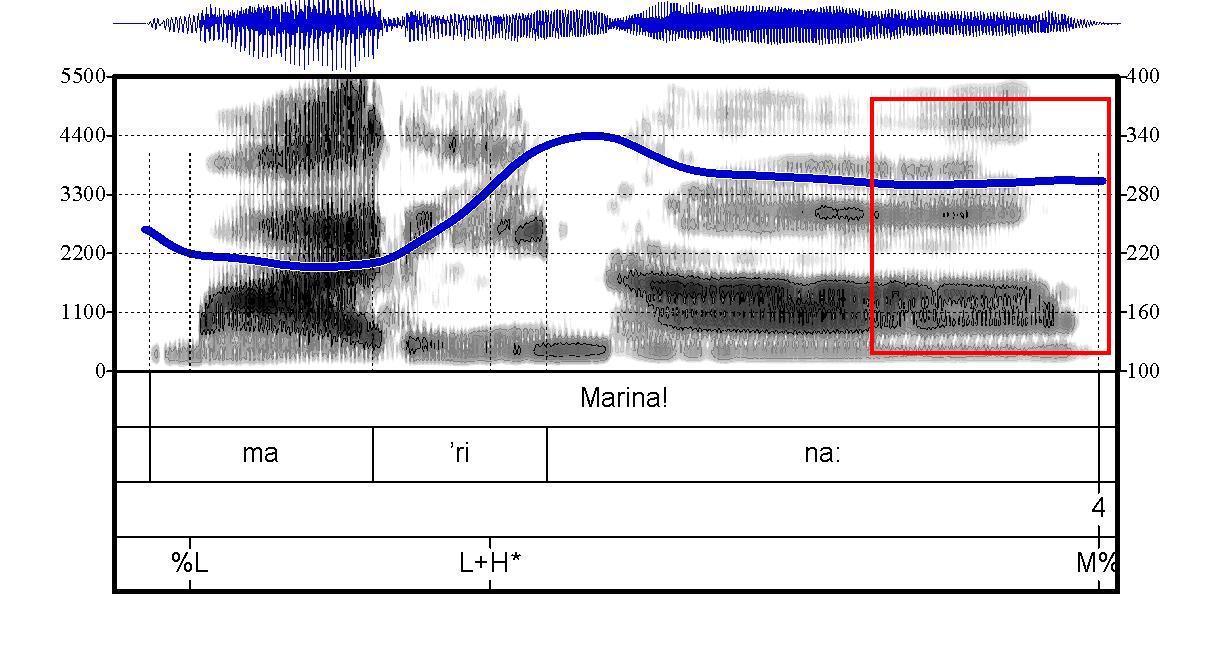
The LH% boundary tone
The yes-no questions with ascending melodic contours and the emphasis in the final position have a stronger prominence due to a low to high pitch variation during the next unaccented syllable, compared to the melodic contours that end in the L* HH% sequence.
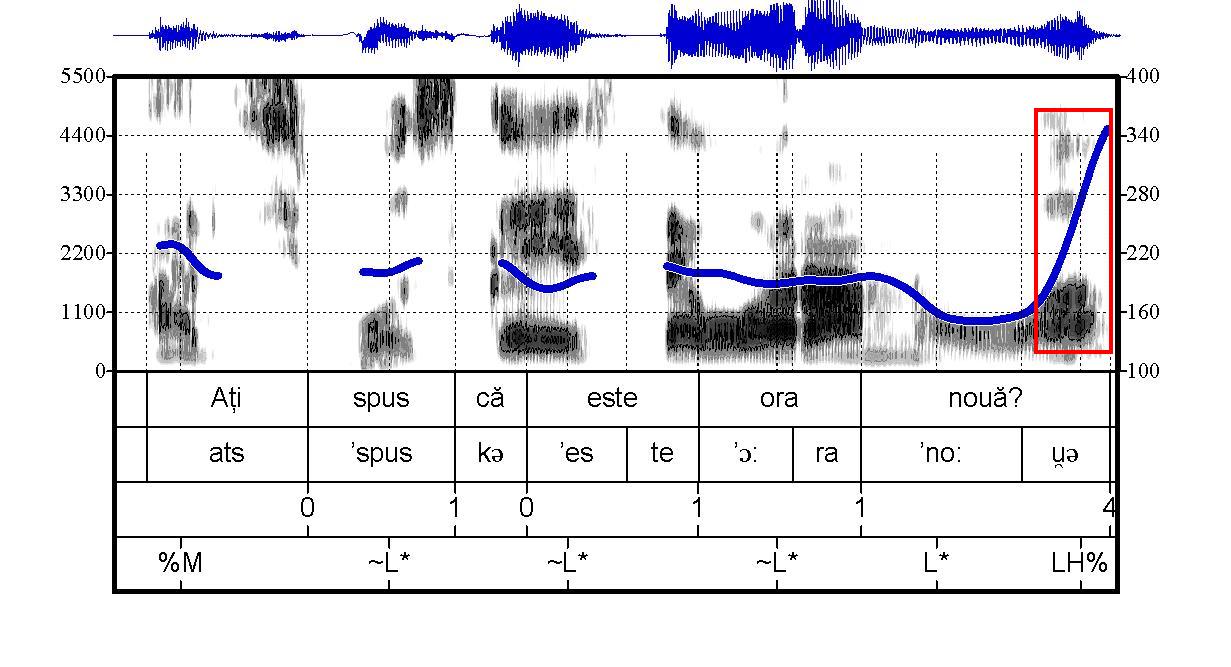
The HL% boundary tone
The yes-no questions with the emphasis in the final position have ascending-descending melodic contours due to a low to high pitch variation during the accented syllable and a high to low pitch variation during the next unaccented syllables.
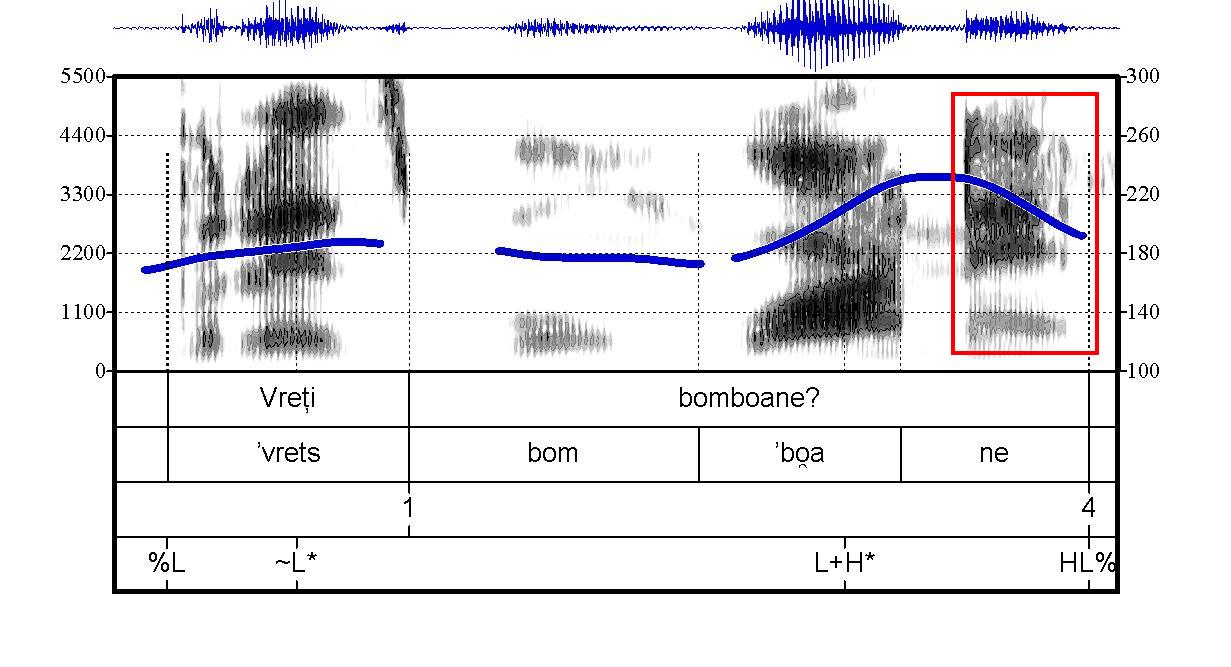
- G. Bruce, Swedish Word Accents in Sentence Perspective, Lund: Gleerup, 1977
- E. Estebas-Vilaplana, P. Prieto, Castilian Spanish intonation, In: Prieto, P.; Roseano, P. (coords.), Transcription of Intonation of the Spanish Language, Lincom Europa: München, pp. 17-48, 2010
- Julia Hirschberg, Mary E. Beckman, The ToBI Annotation Conventions, The OhioState University, 1994
- D. Jitcă, V. Apopei, M. Jitcă, The F0 Contour Modelling as Functional Accentual Unit Sequences, International Journal of Speech Technology, DOI 10.1007/s10772 -009-9055-3, November 4, 2009
- D.R. Ladd, Intonational phonology, Cambridge University Press, pp. 334, 1996
- M. Liberman, The intonational system of English, Doctoral Dissertation, MIT, 1975
- J.B. Pierrehumbert, The Phonology and Phonetics of English Intonation, Ph.D. Dissertation, Cambridge, MIT, 1980
- P. Prieto, Tonal alignment, In: Van Oostendorp M., Ewen C, Hume B., Rice K. (eds.), Companion to Phonology, Wiley-Blackwell, pp. 1185-1203, 2011
